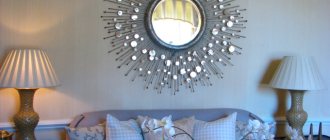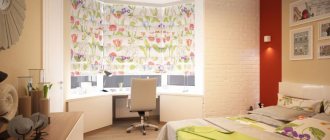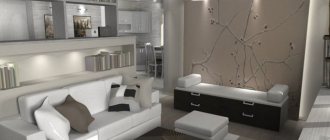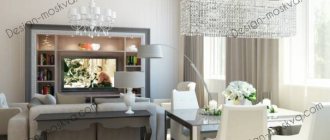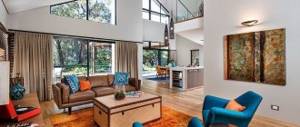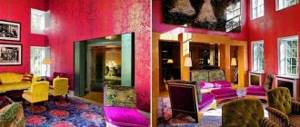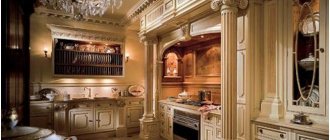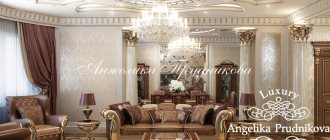Mixing different styles in the interior - 17 photo examples
Handmade decorative elements next to reproductions of famous paintings, classic and modern, furniture from different eras, and all in one room? Someone will say that it is impossible to combine such different elements, and they will be wrong. Mixing different styles in the interior is a popular trend today, to which entire design directions are already dedicated.
Eclecticism, fusion and kitsch are completely different styles, united by one common idea: a harmonious mixture of several interior design trends in one room.
mixing different styles in the living room interior
Exclusivity, individuality, maximum opportunity for self-expression and enormous scope for creativity are the main trump cards that distinguish eclecticism, fusion and kitsch from other trends. However, they also have boundaries that should be adhered to. Even shocking and flashy kitsch should be logical and harmonious. As in any other case, before you begin the renovation, you need to graphically depict the desired result as accurately as possible in order to understand how the interior will look in the end.
Read more about each option for mixing styles in the interior
Photo gallery - a mixture of different styles in the interior:
What design styles should not be mixed in the interior?
In modern interiors you can find a lot of innovations and bold solutions. One of the most important trends is the combination of different styles.
However, not all of them look harmonious with each other, which is why before implementing this idea, you need to carefully study this issue.
The main secret of combining styles is the principle of dominance. This principle is based on the fact that out of several selected, only one is the main one.
Thus, you can make interior design, colors and furniture, guided by one trend, and decor and accessories – another.
In order to achieve a bright and interesting interior design, it is not recommended to combine more than two styles.
However, the classic interior is an exception to the rule; it represents a combination of such trends as: Baroque, Rococo, Classicism, Empire style.
However, despite the fact that they already harmoniously combine with each other, they can be refreshed by adding such trends as Gzhel, vintage, Versailles and others, observing the measure.
Mixing classics with ethnic style is strictly not recommended, as it will look very tasteless.
Classic interiors are very popular for decorating not only residential premises, but also public ones.
It is strictly not recommended to mix luxury with retro, boho, avant-garde, Japanese, Chinese and African styles.
Due to the large number of decor, accessories, different textures and colors, the interior will look absurd.
Giving preference to the classics, it is recommended to focus on design attributes from one design area, otherwise it will lead to clumsiness.
Minimalism cannot be combined with almost anything; being simple and laconic, it does not accept decor and accessories.
Accordingly, when choosing this trend for your interior, you should forget about other styles, otherwise achieving minimalism in the room will become impossible.
Scandinavian style is contraindicated in combining with luxurious interior elements, as this contradicts its essence.
When choosing it, you should understand that the main colors of the interior should remain pastel shades, the materials should be natural, the furniture should be practical, and accessories should be kept to a minimum.
Luxurious classic styles are characterized by the use of colorful, contrasting colors, textured fabrics and a large amount of decor.
Adherents of the Gothic style should carefully approach the recreation of such an interior, since objects from other styles, such as boho, retro, vintage, onto-art and others, are distinguished by bright colors that contradict the Gothic style.
Provence and Renaissance are trends that are completely opposite to Gothic, so taking risks by combining such interior solutions is strictly not recommended.
When choosing an interior for a room, you need to carefully select styles and consider all options.
You need to understand that there are not just different styles that can be combined with each other and get something amazing, but you can also completely ruin everything, even with the smallest details, which will definitely prevent you from achieving the desired result.
What, in your opinion, are incompatible design trends in the interior?
Read more about each option for mixing styles in the interior
Eclecticism
Eclecticism is a conservative and restrained mixture of different design trends. The basis for eclecticism is classics; it serves as a background for elements of more dynamic styles. Eclecticism is the same classic, but with more flexible frames. Baroque, Rococo, Renaissance, Gothic, Scandinavian style, ultra-modern trends - you can dilute the room with their different variations, but it should look harmonious.
eclectic style in the living room
Eclecticism is characterized by:
- Predominance of pastel colors. Here shades of beige and white are most often used, combining them with bright colors and decorative elements.
- A single idea that unites all design directions present in the room. They don't mix more than two or three different styles here. The transitions between them are always smooth.
- The room may contain a small amount of extravagant elements: ethnic or oriental furniture, elements of modernism and impressionism, bright flashy paintings or massive sculptures - all this can be used in decor, but in the end it will look elegant.
- Little color, but a lot of light. An abundance of bright colors is rarely found in eclecticism, but it is not prohibited. The main thing is that the interior is harmonious. If the background is beige, you need to choose colors that will go with it. It is known that different combinations of colors produce completely different effects. Beige color goes well with coral, red, fuchsia, purple, blue, light blue, black. You can add different colors to a beige interior and these combinations will delight you with amazing results: turquoise will create a calming atmosphere, gold and orange will make the interior richer, chocolate and black will add solidity to the room, natural wood will remind you of the richness and beauty of nature.
- Comfort and functionality play an important role in eclecticism.
- The use of geometric elements such as stripes and circles adds dynamism to the interior.
- Patterned wallpaper, parquet flooring, drapery on windows and doorways are classic elements often found in eclecticism.
eclecticism in the kitchen interior
Fusion
Fusion arose when people felt a strong desire to travel and began to bring various little things from everywhere to decorate their homes. This style is famous for its ability to mix different Western and Eastern styles. It is more extravagant than eclecticism, since it mixes more incompatible styles, there is no longer any classical background, more attention is paid to bright colors.
fusion in the living room interior
Features of fusion style:
- A harmonious mixture of seemingly incompatible classical trends in one room. For example, here modernism seamlessly meets boroque and gothic, and is diluted with impressionism. This happens in the fusion and kitsch styles, but fusion, unlike kitsch, must find a common idea in these completely different directions and subordinate the entire room to it.
- It creates a feeling of naturalness, the absence of an exact plan when decorating a room. The interior seemed to appear on its own. Here you can find not two or three, but several styles, eras and colors at once. But this meeting must be harmonious.
- The color scheme can be completely different. These can be calm pastel shades or flashy bright colors. Raspberry, orange, gold, green, light green, turquoise, blue, yellow, violet and lilac colors are often used here. The most important rule is the presence of color unity. You only need to mix colors that are compatible with each other.
- The presence of hand-crafted decorative elements in the interior is becoming an increasingly popular solution for decorating a room in a fusion style.
accessories in the living room in fusion style
Kitsch is an extravagant and flashy style that borders on bad taste and strives to cross this border. This is a mixture of bright, dynamic and flashy styles and colors. It is psychologically difficult to spend a lot of time in a room decorated in this style, so it is most often used in the design of youth centers, nightclubs, cafes, and other public places offering active pastime. Few daredevils are ready to decorate a room like this.
extravagant living room in kitsch style
Despite its apparent simplicity, kitsch is one of the most complex areas of modern design.
Kitsch is characterized by:
- Mixing a large number of bright flashy colors. The most popular colors in this style are red, yellow, blue, light green, green, orange, lilac, blue.
- A combination of the most different styles, different from each other. Eclecticism and fusion combine classic styles, while kitsch features such combinations as country and futurism, neon lamps and candelabra, an antique mirror next to an old road sign.
- A riot of small decorative elements present in abundance: bows, ruffles, souvenirs, soft toys, etc. It gives the feeling of a flea market.
- Extravagance of the interior and a feeling of bad taste in the design.
bright dining room in kitsch style: a combination of red and yellow colors in the interior
Mixing different styles in the interior can give an interesting result. It is important to find unity between different styles, to unite them with a common idea that will permeate the entire space.
Clothing styles and their classification
Watch the video: How to find your clothing style? Duration 9.5 min
Classic as the basis for the theme of clothing styles
So, first you need to start with the classic style, which became popular long before we were born. This is the very basic style that is appropriate in absolutely any situation. If you don't know what to wear, then it's time to rummage through your closet and find something classic.
Where did this style come from and what is it?
The classic style originated in England, because it is there that the English Queen lives, in whose family it is customary to look stern and elegant. It is these two words that imply classic style. He does not tolerate all kinds of flashy details. It is characterized by a loose cut, simplicity of lines, but at the same time obvious restraint and inconspicuousness. The classic style does not involve attracting everyone's attention, but this is simply impossible. This is precisely the special charm of the classical style, to be invisible to oneself, but clearly visible to others. The most important thing is neatness. Clean, ironed items will always attract attention, even if they are bought in a cheap store. Therefore, when choosing a classic style as a permanent one, try to match it.
The disadvantages of the classic style are the constant severity, which in the end can get boring for any fashionista.
Romantic
Romantic style is one of the most favorite for all ladies. It is distinguished by a clear variety of additional elements. Typically, this role is played by a variety of ruffles and lace made from lightweight materials. Yes, they are one of the main calling cards of the romantic style. Light, almost weightless fabrics and delicate shades allow designers to create a real aura of innocence around everyone who decides to try on this look.
WhatsApp here
Sports
The sporty style is one of the most comfortable, but not always suitable for all occasions. For example, showing up to a gala reception in sneakers means demonstrating bad taste. That is why you need to be able to combine sports items (sport chic items) in your wardrobe with more neutral ones. In general, sportswear is always comfortable and allows you to feel comfortable in any situation.
Derby style
The style has the characteristic features of the jockey style:
- checkered jacket;
- hat - a bowler hat with a small visor;
- Wellingtons.
Derby style can emphasize femininity, originality and will definitely give convenience and comfort. And the feeling that a woman has just come from the hippodrome will add mystery and a touch of aristocracy to her image.
Casual style
More recently, a new style, Casual, has emerged, which is preferred by most people in different countries. It implies freedom and self-expression in clothing. Modern, fashionable, stylish, but with classic elements, this is what distinguishes Casual from other styles. Many experts believe that Casual is a “prefabricated” style. Since in it you can find a sufficient number of elements included in other clothing styles. Of course, there are also sporting elements here, but it is not at all customary to play sports in these clothes.
Business style
Business style clothing is a branch of the classical style and contains many elements of English aristocratic society. They usually wear such clothes at work, in the office and at other important events. Business attire implies restraint and elegance. In addition, short items of clothing should not be allowed, as for many office dress codes this can be inappropriate and tasteless.
Parisian chic
The style of real French women, who cannot be accused of lack of taste. They are always refined, open, elegant and uniquely feminine. The style is characterized by a simple but elegant cut, a combination of pastel colors with elegant pumps with small heels. A contrasting beret can complement your look.
Scandinavian style
Those who love comfort and coziness should pay attention to the Scandinavian style. The style is distinguished by restraint and simplicity. And the abundance of small patterns, designs and various shades of calm colors does not allow it to be considered boring.
boho
This style is in the spirit of those who love freedom, ease and, as it were, detachment from the crowd. Boho is characterized by:
- natural materials;
- bright prints;
- lace;
- tassels, fringe;
- loose sandals or boots in a cowboy style;
- jewelry, belts, sashes.
Boho is not characterized by such features as strict lines, orderliness of elements and excessive neatness.
Hippie style
Hippies are distinguished from other styles by a philosophy of peace and love, which is expressed in long, flowing hair, rock and roll and flowers.
The hippie style look includes trousers or bell-bottom jeans, loose T-shirts, shirts, tops made from natural materials, worn leather and denim vests and jackets, and an abundance of simple and bright accessories in the form of baubles, ribbons, and headbands. Hippie colors include all sorts of bright, including acidic shades. The drawings are mostly irregular geometric shapes or bright round ones, as if created during a dope. This style excludes branded clothing, logos and labels as such. Bright daub is better than prints and regular shapes. Shoes are simple, without heels or frills: flip-flops, sandals, bright sneakers or bare feet.
Art Deco
This style combines simple loose dresses with outrageous, colorful accessories. Accessories may include flirty hats with feathers, long glass beads and handbags decorated with sequins or beads.
Patchwork
Patchwork is literally a product made from scraps. Accordingly, the patchwork style has a patchwork base. You have probably encountered elements of this style many times, both on women and children, and on men. By the way, today patchwork is very popular and in demand. Therefore, in everyday life you can see coats, jackets, dresses, stoles, bags and even shoes made from scraps.
Extravagant style
This style of clothing can be considered one of the most scandalous today. Those who want to stand out from the crowd wear unusual, bright clothes, which are called extravagant. Various asymmetries, bright, provocative colors - all this symbolizes this particular style.
Swag style
This style involves wearing ostentatiously expensive things that attract attention and scream about their expensiveness. If it’s a chain, it’s as thick as a finger; if it’s a ring, it’s very large. If it is a branded item, then it must have a visible logo. That is, Swag is a style that screams wealth.
Color blocking style
This style is distinguished by a play of colors, not models. Color blocking combines contrasting colors that work well together. At the same time, the image should not look ridiculous; the colors should be harmonious, monochromatic, without prints or unnecessary details.
Eclectic style
One of the most ridiculous, but valid, is the eclectic style. Which means an absurd combination of incongruous things. Summer light shorts with a fur coat, a business jacket with tights, a tracksuit with heels and polka dot socks - this and much more can be attributed to this style. But there is one thing. This style is not always clownish and ridiculous. There are outrageous people who can afford to use this style and at the same time look individual and interesting. Among her contemporaries we can name Zhanna Aguzarova, who has popularity, fame, individuality and at the same time deftly handles the eclectic style.
Erotic style
The style became popular a long time ago. It involves tight-fitting clothing, that is, it emphasizes all parts of the figure as much as possible. In most cases, clothing is revealing, and sometimes even provocative.
Ethnic style
Ethnic style of clothing can be found much less frequently, however, it is found nowadays. Loose clothes, easy fit and, of course, folk patterns, depending on the culture of the people you choose. In any case, ethnic style looks unusual, easy, but not always appropriate.
Colonial style
White cotton fabrics in simple and comfortable styles with a retro touch are what colonial style is all about. This style is similar to the safari style, but only in the simplicity and convenience of the styles. It is an integral part of the summer season and beach fashion.
Minimalism
Minimalism presupposes the absence of unnecessary decorative elements in clothing items. Today this means:
- loose fit,
- lack of decorations,
- discreet colors.
Safari style
In the distant nineties, another style appeared, which was called Safari. Some of it is taken from the English military uniform, but in general the clothing suggests comfort and convenience for the traveler. At that time, colors were very popular, with the help of which one could “merge” with the atmosphere, that is, earthy, marsh, brown. However, a little later, complete freedom of color appeared and various overalls began to be produced in bright shades. It was stylish, daring and unusual. Nowadays, Safari can rarely be found in Russia, because it is predominantly an American style.
Military style
The American military shared another style with us. Military has become popular quite a long time ago and every girl looks completely different in it. Heavy boots, lace-ups, and marsh colors are the perfect combination for this style. Moreover, today this style has reached its peak and is present not only in adult, but also in children's fashion.
Preppy
Preppy style suggests a pro college stylistic direction. This is the style of golden youth students who prefer stylish, branded clothing from famous fashion houses. The main characteristic features of this style are calm, deep colors, noble natural fabrics, restrained styles, and classic prints (checks, stripes). Most often, young people in preppy style can see a plain or checkered shirt, a classic jacket or vest, loafers and a briefcase bag.
Grunge
This style is mainly preferred by young people because of its ease, bordering on carelessness, and sometimes even untidiness. Because it includes torn elements, turned up sleeves and trouser legs, a mess on the head, wrinkled elements of clothing, and rough shoes. Grunge is the style of people tired of luxury and glamor. But with all this, this style can look fashionable and stylish.
Glamor style
This style implies brilliance and chic. But in glamor all this should look discreet, stylish, expensive and aristocratic. Silk fabrics, jewelry, stylish hairstyle, expensive accessories, well-groomed hands, absolute harmony and gloss.
Avant-garde style
The avant-garde style was introduced into fashion by Pierre Cardin and combines:
- A riot of colors and shades, including acidic ones. At the same time, elements of clothing, accessories, as well as hair and makeup can be bright;
- Unusual materials, including eco-friendly cheap ones or, on the contrary, exotic expensive ones. The materials may be plastic, corrugated paper, cardboard, peacock feathers or other materials;
- Intricate styles, including both overly voluminous models and angular geometric ones, with spikes, needles, ribbons;
- A mixture of styles, as it can combine elements of romance, classics, glamor and gothic, which ultimately will help create a completely new image;
- Exoticism, which is limited only by the imagination of the creator of the image.
Bohemian style
Bohemia literally translates as gypsy, elements of which are present in this style. Although today the bohemian style has changed quite a lot and has changed from what it was at the beginning of its history. What remains of the gypsy style is the brightness of colors, an abundance of accessories and the effects of wear. At the same time, the bohemian style is the style of the creative elite who love freedom, ease, love to attract attention to their image and at the same time manage to feel as comfortable as possible.
Things in a bohemian style should be practical in both color and composition. That is why colored, multi-color materials are usually used. Flowers, gradients, watercolor motifs combined with plain elements are welcome. As well as aged clothing, with torn edges and simple or deliberately aged accessories. Such accessories can be leather bracelets, antique brooches, scarves, headbands, bags, rings and earrings made of shabby gold. Simple and comfortable shoes without heels can complement your look.
Gypsy style
Another style taken from nomadic gypsies is Gypsy. The style is based on a combination of layered skirts, dresses with floral prints and bright accessories. Gypsy has a lot in common with boho and bohemian style, but is distinguished by the obligatory layering.
Sea style
Time did not stand still and the sailors managed to share something with us. Yes, the nautical style has become one of the popular ones and remains so to this day. True, at first these were brighter things; over time, vests remained especially popular. Most people still continue to wear them, alternating with white clothes, such as trousers and skirts. This style is an integral part of every fashionista’s summer wardrobe and is sure to accompany her to the sea or the beach.
Linen style
In the lingerie style, as the name itself suggests, the design and features of underwear are taken as the basis. This is openness, an abundance of lace, airy transparent and/or satin elements, embroidery. This style is quite popular today, especially with neoprene tops.
Vamp style
Over time, girls began to express themselves more openly, that is, to bare their shoulders and open their cleavage. Bright, provocative colors appeared, red and purple were especially popular. This is how the vamp style appeared. If you see a girl with scarlet lips and gothic elements, then this is definitely someone who prefers a vamp style.
Garson style
As the name suggests, it was borrowed from men and involves wearing men's clothes, for example, tuxedos, tailcoats, jackets, and men's hats. That is, things that are not typical for a woman’s wardrobe.
Disco style
If you are going to a club, do not forget about the disco style, which became popular back in the seventies. Bright dresses, suits trimmed with sequins - all this became a favorite clothing back in the seventies. And it is still in demand in certain circles.
Oversized look
Modern style has given us an oversized look. Modern youth prefers it and associates it with the distant nineties. Large knitted sweaters, coats, huge T-shirts three sizes too big, always tucked into tight pants or pale banana jeans. This is exactly what oversized means, which will definitely be popular for several more years.
Gaucho style
This style is the style of Spanish cattle breeders. Which are characterized by a variety of ponchos, wide-brimmed hats, scarves and wide trousers of a men's cut.
Country style
The famous rustic style of cowboys, which became known as country style. Loose clothing, plaid shirts and hats, and high boots. I just want to get on a horse and race across the meadow! Today, a plaid shirt tucked into jeans still remains relevant.
Rustic style
From the country style comes a rougher variation, called the rustic style. Involves clothing made of rough fabric and genuine leather.
Ecological style
In the modern world, you can often find natural things that are associated with an ecological style. It involves light shades, patterns of greenery, leaves. Often clothes are made from natural materials.
City style
The opposite of country style, namely urban style, is very popular in Hollywood. The fabrics must be of high quality, but the outfits are not loose, but tightly fitting to the figure. Perfectly straight lines, an image thought out to the smallest detail - all this has become a clear expression of urban style.
New look style
After World War II, Christian Dior decided to rid women of boring boxy jackets by opening up the shoulders and adding fuller skirts. Bright skirts, which were loved by millions of women around the world, became one of the most fashionable and unusual, and the style was called New Look.
Floor style
The storey style became popular thanks to designers who decided to come up with layers of clothing. Jackets, shirts, cardigans - all this is used in the layered style and suggests the presence of a “cabbage” (multi-layer) style.
Pajama style
Pajama style is perhaps one of the most comfortable types of clothing, involving vertical stripes, loose pants, and wide shirts. Maximum free, convenient, comfortable and at the same time fashionable and stylish.
Men's style
As for men's style, it should be noted that it is one of the most complex. Today it is necessary to carefully select men's clothing so that it looks truly beautiful, bold and unusual. The most popular elements of men's style today are wide-leg trousers, boyfriend trousers and body shirts of various styles and colors.
Retro style
Retro style is another fashion trend that became popular after the 50s. The style implies elegance, simplicity of styles and delicate colors. This style looks very feminine. It actively uses fringe and various embroideries.
Gothic style
Japan gave us the Gothic Lolita style, which is more preferred by the so-called cosplayers. Heavy colors combined with a cute girl image has been one of the Japanese favorites since the year 2000.
A cosplayer is a follower of a computer game, film, literary work, or comic book who reproduces not only the external image of her prototype, but also his character, movements, and lifestyle. That is, with the advent of such a heroine as Lolita, representatives of the fair sex appeared who reincarnated into their ideal and went through life in a new image and a new style. Cosplay as a hobby or way of thinking appeared in 1930 and is now at the peak of its development. General computerization, gambling addiction, and the development of anime contribute to the development of cosplay. At the same time, not only young girls, but also quite mature representatives of our society can be cosplayers.
Vintage style
By the way, our mothers’ things are called vintage style and remain popular to this day. These are unusual and bright colors, as well as the predominant use of satin and silk materials. It is quite comfortable and appropriate to wear at parties.
Chanel style
After the famous Chanel began to dictate fashion, a style appeared that was named after her. This is more of an English trend, which involves the presence of jackets and knee-length skirts. It can also be compared to the style of the English queen. Chanel style is femininity and lightness in every movement.
It is impossible to be innovative all the time. I want to create classics!
K. Chanel
In addition to the above clothing styles, there are also so-called rock styles, which we have separated into a separate block.
Options for mixing styles - eclecticism, fusion and kitsch
Finding an interior that would be strictly within the confines of one specific style is quite difficult. Yes, there are rooms, entering which you can confidently say - here it is, a classic in its purest form. However, most often designers and homeowners themselves decide to experiment and combine two or three, and often several, traditional styles in one interior.
This mixture also has its own rules, features and characteristics, which made it possible to identify three main options for combining styles - eclecticism, fusion and kitsch.
What is the difference between these three areas of interior design? What rules can exist where it is decided to deviate from the basic principles of “pure style”? And is kitsch really so terrible, which has long become a symbol of bad taste, shockingness and gross violation of all the canons and traditions of design? Let's figure it out together with rmnt.
A wicker bed with a colorful bedspread looks especially exotic in the center of a distinctly laconic room in a classic style.
Eclecticism
The oldest of the styles that arose from a mixture of several design directions, so let's start with it. At the beginning of the 19th century, when the classics had already become commonplace, and wealthy homeowners wanted to surprise guests with something new, a style appeared that was a mixture of two or three main trends that existed at that time. Eclecticism was especially popular from about the 1830s until the end of the 19th century.
Compared to the then dominant classical style, eclecticism provided much greater scope for experimentation and the embodiment of the wildest fantasies, but at the same time did not go beyond the bounds of decency and generally accepted traditions.
Most often, eclecticism mixes only two interior styles, for example, classic and more luxurious baroque, solemn empire style and dynamic modern. Typically, eclecticism introduced notes of exoticism or original details into the classic interior style, so it can be called basic and fundamental for this design direction.
Eclecticism for its harmonious and cozy mixture of styles, in general, is still the same classic, just in a light and unobtrusive reworking. Eclecticism can be described as a well-known dish - a classic interior, which is served with a new, often quite spicy and original sauce.
Main characteristics of eclecticism:
- A combination of pastel colors that distinguish a classic style with brighter shades.
- Introducing individual details from exotic styles, for example, oriental ornaments into strict European classics.
- A combination of antique furniture and ultra-modern details, such as plastic chairs and glass and concrete finishes.
- Eclecticism loves silk wallpaper with large expressive patterns, leather furniture, a combination of different wall decorations - one wall can be painted with a single color paint, and the second can be lined with wooden panels or artificial stone.
- The basis of eclecticism is always the classics, which can be combined with baroque, gothic, renaissance, rococo, colonial style and individual elements of exotic, ethnic trends.
- In eclecticism it is not customary to mix more than two or three main interior styles.
Eclecticism is perfect for those homeowners who, in spite of everything, prefer the classics, but at the same time would like to move away from its strict canons and clear lines. Eclecticism can soften a classic interior, make it more modern and dynamic
To work/study
Business classics + romance
We choose a trouser suit that is trendy now, add a blouse with frills and shoes with a pointed toe and a stable heel and get an ultra-fashionable work and school outfit. More dynamic young ladies can wear flat loafers instead of shoes. The color scheme of the suit can be any. In addition, for warm, fine everyday life, you can choose shorts instead of trousers, and wear sneakers or sneakers instead of shoes, and then sports will be added to the mixture of classics and romance.
- Trends
Which sandals will help you get less tired - Trends
“It used to be that women’s pajamas were underwear for frivolous people”: an etiquette expert on what clothes to wear to greet guests
instagram.com/thecablook
instagram.com/sophiesavenue
*Of course, these examples are for those whose work dress code allows experiments.
Fusion
The English term “fusion” is more familiar to culinary enthusiasts. In the field of cooking, this name means an author's direction, which has absorbed all the best from the culinary traditions of the West and the East.
In the field of interior design, fusion also means the free mixing of a variety of styles and trends. This style “outside styles” arose on its own, naturally, so there is no specific author for this design direction. It’s just that in the 20th century, people began to travel much more often than before, the most distant exotic countries became more accessible, and when returning from travels, they really wanted to bring something with them as a souvenir to decorate the interior.

